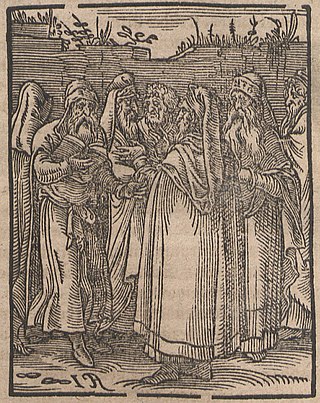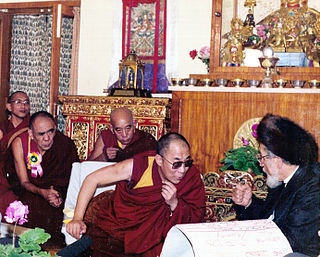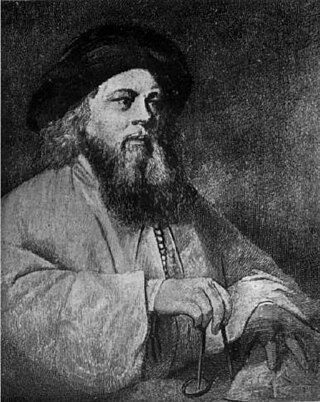Related Research Articles

Kabbalah is an esoteric method, discipline and school of thought in Jewish mysticism. A traditional Kabbalist is called a Mekubbal. The definition of Kabbalah varies according to the tradition and aims of those following it, from its origin in medieval Judaism to its later adaptations in Western esotericism. Jewish Kabbalah is a set of esoteric teachings meant to explain the relationship between the unchanging, eternal God—the mysterious Ein Sof —and the mortal, finite universe. It forms the foundation of mystical religious interpretations within Judaism.

Meshullam Zalman Schachter-Shalomi, commonly called "Reb Zalman", was one of the founders of the Jewish Renewal movement and an innovator in ecumenical dialogue.

The Tanya is an early work of Hasidic philosophy, by Rabbi Shneur Zalman of Liadi, the founder of Chabad Hasidism, first published in 1796. Its formal title is Likkutei Amarim, but is more commonly known by its first Hebrew word tanya, which means "it has been taught", where he refers to a baraita section in "Niddah", at the end of chapter 3, 30b. Tanya is composed of five sections that define Hasidic mystical psychology and theology as a handbook for daily spiritual life in Jewish observance.

Jewish Renewal is a Jewish religious movement originating in the 20th century that endeavors to reinvigorate modern Judaism with Kabbalistic, Hasidic, and musical practices. Specifically, it seeks to reintroduce the "ancient Judaic traditions of mysticism and meditation, gender equality and ecstatic prayer" to synagogue services. It is distinct from the baal teshuva movement of return to Orthodox Judaism.
Jewish religious movements, sometimes called "denominations", include different groups within Judaism which have developed among Jews from ancient times. Today, the most prominent divisions are between traditionalist Orthodox movements and modernist movements such as Conservative, Reform Judaism, and smaller others.
Neo-Hasidism, Neochassidut, or Neo-Chassidus, is an approach to Judaism in which people learn beliefs and practices of Hasidic Judaism, and incorporate it into their own lives or prayer communities, yet without formally joining a Hasidic group. Over the last century neo-Hasidism was popularized by the works of writers such as Hillel Zeitlin, Martin Buber, Abraham Joshua Heschel, Lawrence Kushner, Zalman Schachter-Shalomi, and Arthur Green.
Academic study of Jewish mysticism, especially since Gershom Scholem's Major Trends in Jewish Mysticism (1941), draws distinctions between different forms of mysticism which were practiced in different eras of Jewish history. Of these, Kabbalah, which emerged in 12th-century Europe, is the most well known, but it is not the only typological form, nor was it the first form which emerged. Among the previous forms were Merkabah mysticism, and Ashkenazi Hasidim around the time of the emergence of Kabbalah.

A maggid, also spelled as magid, is a traditional Jewish religious itinerant preacher, skilled as a narrator of Torah and religious stories. A chaplain of the more scholarly sort is called a darshan. The title of maggid mesharim probably dates from the sixteenth century.
Devekut, debekuth, deveikuth or deveikus is a Jewish concept referring to closeness to God. It may refer to a deep, trance-like meditative state attained during Jewish prayer, Torah study, or when performing the 613 mitzvot. It is particularly associated with the Jewish mystical tradition.

Rodger Kamenetz is an American poet and author best known for The Jew in the Lotus (1994), an account of the historic dialogue between rabbis and the XIV Dalai Lama. His poetry explores the Jewish experience and in recent years, dream consciousness. Since 2003 he's been instrumental in developing Natural Dreamwork, a practice that focuses on the sacred encounters in dreams.
Hasidic philosophy or Hasidism, alternatively transliterated as Hasidut or Chassidus, consists of the teachings of the Hasidic movement, which are the teachings of the Hasidic rebbes, often in the form of commentary on the Torah and Kabbalah. Hasidism deals with a range of spiritual concepts such as God, the soul, and the Torah, dealing with esoteric matters but often making them understandable, applicable and finding practical expressions.

Hillel Zeitlin (1871–1942) was a Ashkenazi Yiddish and Hebrew writer and poet. A leading pre-Holocaust Jewish journalist, he was a regular contributor to the Yiddish newspaper Moment, among other literary activities. He was the leading thinker in the movement of pre-World War II "philosophical Neo-Hasidism".
Lurianic Kabbalah is a school of kabbalah named after Isaac Luria (1534–1572), the Jewish rabbi who developed it. Lurianic Kabbalah gave a seminal new account of Kabbalistic thought that its followers synthesised with, and read into, the earlier Kabbalah of the Zohar that had disseminated in Medieval circles.

Arthur Green is an American scholar of Jewish mysticism and Neo-Hasidic theologian. He was a founding dean of the non-denominational rabbinical program at Hebrew College in Boston. He describes himself as an American Jew who was educated entirely by the generation of immigrant Jewish intellectuals cast up on American shores by World War II.

The concepts and structures of Jewish Kabbalah have been used in the contemporary world to open comparative dialogue and cross-fertilization with modern secular disciplines in the Sciences and Humanities. This has been an uncommon phenomenon, since it requires wide internal understanding of both traditionalist Kabbalah and modern secular thought, and for social reasons Jewish modernity has seen isolation and entrenchment between the two. Skilled authorities in both traditions have included contemporary traditionalist Orthodox teachers of Kabbalah, as well as Neo-Kabbalistic and Academic scholars who read Kabbalah in a critical, universalist way.

Chabad philosophy comprises the teachings of the leaders of Chabad-Lubavitch, a Hasidic movement. Chabad Hasidic philosophy focuses on religious concepts such as God, the soul, and the meaning of the Jewish commandments.
Nine and a Half Mystics: The Kabbala Today is a 1969 book on Jewish mysticism by Rabbi Herbert Weiner. The book includes interviews with a number of Jewish mystics and scholars, as well as the author's encounters with various Jewish groups practicing who incorporate mysticism in their religious practice.

A Baal Shem was a historical Jewish practitioner of Practical Kabbalah and supposed miracle worker. Employing the names of God, angels, Satan and other spirits, Baalei Shem are claimed to heal, enact miracles, perform exorcisms, treat various health issues, curb epidemics, protect people from disaster due to fire, robbery or the evil eye, foresee the future, decipher dreams, and bless those who sought his powers.
References
- 1 2 3 Rabbi Herbert Weiner. NJ Jewish News. Accessed March 7, 2014.
- ↑ "Herbert Weiner". Essex News Daily. Accessed March 10, 2014. Archived March 9, 2014, at the Wayback Machine
- ↑ Kaplan, Dana Evan. Contemporary American Judaism: Transformation and Renewal. Columbia University Press, Aug 13, 2013. Accessed March 7, 2014.
- ↑ "9 1/2 Mystics: The Kabbala Today Today" by Herbert Weiner. Commentary Magazine. Accessed March 7, 2014.
- ↑ Rabbi Herbert Weiner. The Star Ledger. Accessed March 7, 2014.
- ↑ Rabbi Arthur Green. Jewish Foundation. Accessed March 9, 2014.